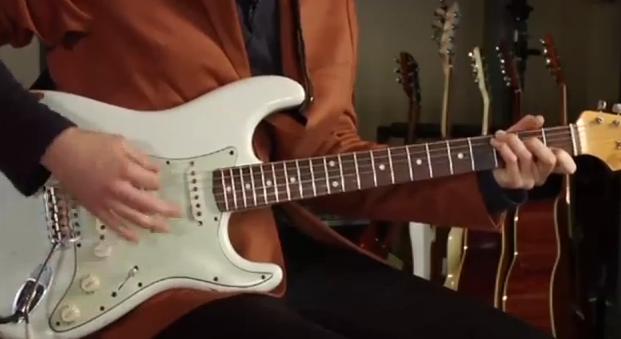check out the Ultimate Guitar Song Collection
Tom Petty style easy acoustic guitar song lesson
Hey, guys. Claude Johnson here from guitarcontrol.com.
Thank God it’s Friday and I’m excited to be with you.
I want to talk about learning songs and strumming and
I want to show you a cool Tom Petty song that you can
add to your repertoire right now.
Lately I’ve been on this super simple song kick. We
did the Elvis, “Blue Suede Shoes” with three chords,
Lenny Kravitz song with four chords. These songs are
great because they’re really hard to forget. You can
memorize a song, but then if you don’t practice it you
kind of don’t remember all the parts. Well, these songs,
because they’re so simple, are going to stay with you for
years and years. In fact, when I did this Claustin Powers
movie, I did a spoof of this Tom Petty song that I’m
going to show you, and I hadn’t played it in probably
ten years and I still remembered the chords.
The thing is, even if you don’t remember all the chords,
I mean, there’s only four chords, but let’s just say you
remember the first two, the rest will come back to you or
you can use trial and error to kind of figure out what it was.
This song, again, is just four chords all the way through.
The verse and the chorus are going to sound different
because of the vocal melodies, which I’ll show you in
a sec. But here’s the chords: F, C, A minor and G.
Now, your F chord, it’s like a partial barre chord.
What I’m doing is with — I got my ring finger 3rd
fret D string, middle finger is 2nd fret G string and
then 1st finger on the B string and high E string.
So it’s kind of like this full F chord, except you
don’t have to try that hard. It’s a lot easier to
finger. So it’s a great movable shape you should
learn. We’re going to use it in other songs soon.
So we’ve got F, C, A minor, G. The C, A minor and G are
just from the family of easy open position chords, which
you should know, which I talk about all the time. If you
don’t know you can check out ultimatebeginnerguitar.com.
That strum pattern, you can just copy it if you want.
Just use your ear, just feel it out. That’s one way to
learn it. The other way it to count it out, and the count
would be one-and, two-and, and, four-and. What
I mean by that, think about the basis for all your
strum patterns — well, not all, but most of your
strum patterns is going to be a four count. So it’s
going to be one, two, three, four; one, two, three,
four, over and over. You’re going to fit your strums
into that framework. One, two, three, four, that’s
quarter notes. Now let’s break it down one step
further into eighth notes. You would count one-and,
two-and, three-and, four-and; one-and, two-and,
three-and, four-and.
With this, we’re playing on the one, the and, the two,
the and, but that and we’re going to stretch out. So
it’s like one-and; two-aaaaand. Okay? So instead of
one-and, two-and, three-and, four-and; one-and,
two-aaand. And you’re stretching that out into the
start of the third beat. Then you pick it up again
with the and of the three beat. So it’s one-and,
two-and, and, four-and. Okay? I hope that makes
sense.
With this particular song — first let me say that is a
very common strum pattern. So pick any chord — forget
the song for a second. Let’s just work on that. Just
take E minor. That strum is used in almost every song.
Not every song, but so many songs.
Back to the Tom Petty song. What we’re doing here is
going to be one-and, two-and, so when you hit that
long and you’re going to switch chords. So it’s really
like half a bar of F, half a bar of C. Technically it’s
not half because you’re starting a beat early; it’s on
the and. Just think of it like this: one-and, two-and,
and, four-and; one-and, two-and, and, four-and. So on
the and I’m switching from the F to the C and then the
next part I’m switching from the A minor to the G,
again, on that long and. Okay? So that’s pretty much it.
Just with the vocals, all the songs that you play with
your repertoire — it’s all about building your repertoire.
That’s why I say it’s really good to learn these easy songs
because you can practice all your lead guitar all day long,
but when you’re hanging out with people or on the stage or
whatever, no one wants to hear you just playing solos and
stuff. So you’ve got to have songs, right?
When you’re learning songs and building your repertoire
it’s good to be able to sing a little bit of the song
just to convey the melody. If I strum the chords and
sing the verse it would sound a little something like
this. And the chorus would be something like this.
So there you have it; another great song you can add to your
repertoire right now. I hope you enjoyed that. I hope you
learn this song. Once again, for the ultimate in song
repertoire building, check out the Guitar Song Collection.
It gets into a little bit more complex songs, but that’s okay
sometimes. We want to do both. Get the basics in our bag and
also maybe tackle some of our more favorite songs that have a
few more chords. So check that out at guitarsongcollection.com
and have a great weekend and thanks for watching. I’ll catch
you next time. Take care.






